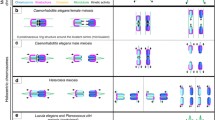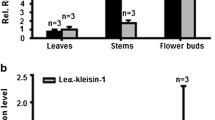Summary
-
(1)
In the chromosomes ofAgapanthus umbellatus the kinetochore can be seen to be divided as early as pro-metaphase II. At this stage, the two longitudinal halves of the kinetochore are individualized and separated from each other. The region of the chromosome body that appears to be responsible for holding together the two sister chromatids of each chromosome until the beginning of anaphase II is the most proximal region of the arms and not the kinetochore.
-
(2)
At the second division of meiosis, three regions with distinct cycles of division may be distinguished in the chromosomes of this species: (1) the kinetochore which can be seen to be divided from prometaphase II, (2) the most proximal regions of the arms which only divide at the beginning of anaphase II and (3) the rest of the chromosome arms which appears to be divided from early prophase II. The concept of division is revised.
-
(3)
The kinetochore has its own cycle of division but does not appear to take direct part in holding together the two sister chromatids of each chromosome until the beginning of anaphase II. The fact that this last property appears to be situated in the arms has several implications. The behaviour of t-ends and of the regions of the B chromosome types responsible for the phenomenon of non-disjunction can be better understood in the light of this finding. In addition, the particular type of division of the mitotic chromosomes ofUlophysema öresundense can be more easily interpreted.
Similar content being viewed by others
Literature cited
Bosemark, N. O.: Accessory chromosomes inFestuca pratensis Huds. Hereditas36, 366–368 (1950).
Darlington, C. D.: Recent advances in cytology, 2nd ed. London 1937.
Håkansson, A.: Behaviour of accessory rye chromosomes in the embryo-sac. Hereditas34, 35–59 (1948).
Koslov, V. E.: Observations on the kinetochore of mitotic chromosomes. Biol. Zhurn.6, 759–766 (1937).
Lima-de-Faria, A.: B chromosomes of rye at pachytene. Portugal. Acta Biol.,A 2, 167–174 (1948).
—: The structure of the centromere of the chromosomes of rye. Hereditas35, 77–85 (1949a).
—: Genetics, origin and evolution of kinetochores. Hereditas35, 422–444 (1949b).
—: The Feulgen test applied to centromeric chromomeres. Hereditas36, 60–74 (1950).
—: Chromomere analysis of the chromosome complement of rye. Chromosoma5, 1–68 (1952).
Melander, Y.: Studies on the chromosomes ofUlophysema öresundense. Hereditas36, 233–255 (1950).
Müntzing, A.: Cytological studies of extra fragment chromosomes in rye. III. The mechanism of non-disjunction at the pollen mitosis. Hereditas32, 97–119 (1946).
Östergren, G.: Heterochromatic B-chromosomes inAnthoxanthum. Hereditas33, 261–296 (1947).
Schrader, F.: The structure of the kinetochore at meiosis. Chromosoma1, 230–237 (1939).
Author information
Authors and Affiliations
Rights and permissions
About this article
Cite this article
Lima-de-Faria, A. The regions of special cycle of division of Agapanthus chromosomes. Chromosoma 6, 33–44 (1953). https://doi.org/10.1007/BF01259929
Received:
Issue Date:
DOI: https://doi.org/10.1007/BF01259929




